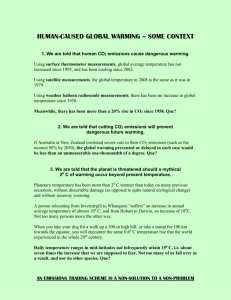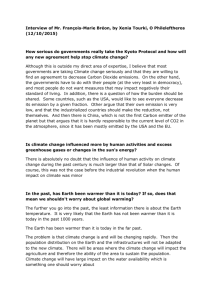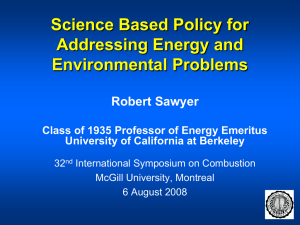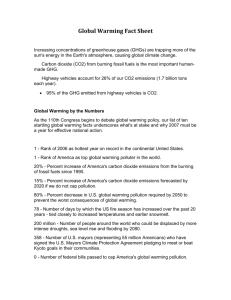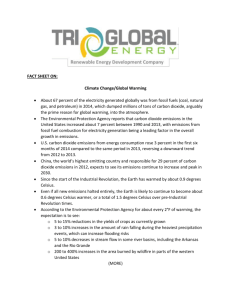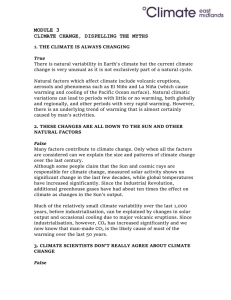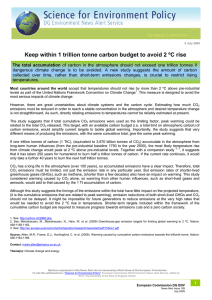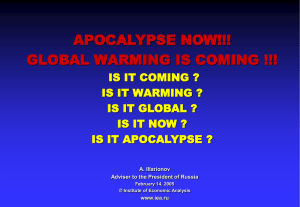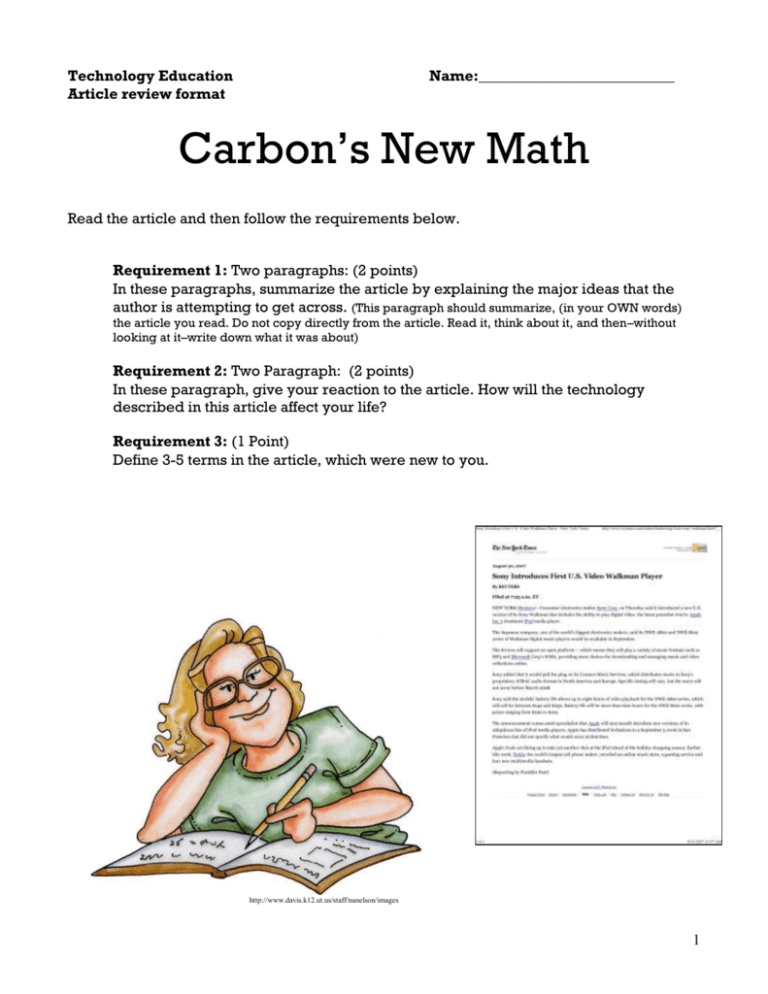
Technology Education
Article review format
Name:__________________________
Carbon’s New Math
Read the article and then follow the requirements below.
Requirement 1: Two paragraphs: (2 points)
In these paragraphs, summarize the article by explaining the major ideas that the
author is attempting to get across. (This paragraph should summarize, (in your OWN words)
the article you read. Do not copy directly from the article. Read it, think about it, and then–without
looking at it–write down what it was about)
Requirement 2: Two Paragraph: (2 points)
In these paragraph, give your reaction to the article. How will the technology
described in this article affect your life?
Requirement 3: (1 Point)
Define 3-5 terms in the article, which were new to you.
http://www.davis.k12.ut.us/staff/nanelson/images
1
Published: October 2007 Confronting Carbon
Carbon's New Math
To deal with global warming, the first step is to do the numbers.
By Bill McKibben
Here's how it works. Before the industrial revolution, the
Earth's atmosphere contained about 280 parts per million of
carbon dioxide. That was a good amount—"good" defined as "what
we were used to." Since the molecular structure of carbon
dioxide traps heat near the planet's surface that would
otherwise radiate back out to space, civilization grew up in a
world whose thermostat was set by that number. It equated to a
global average temperature of about 57 degrees Fahrenheit (about
14 degrees Celsius), which in turn equated to all the places we
built our cities, all the crops we learned to grow and eat, all
the water supplies we learned to depend on, even the passage of
the seasons that, at higher latitudes, set our psychological
calendars.
Once we started burning coal and gas and oil to power our lives,
that 280 number started to rise. When we began measuring in the
late 1950s, it had already reached the 315 level. Now it's at
380, and increasing by roughly two parts per million annually.
That doesn't sound like very much, but it turns out that the
extra heat that CO2 traps, a couple of watts per square meter of
2
the Earth's surface, is enough to warm the planet considerably.
We've raised the temperature more than a degree Fahrenheit (0.56
degrees Celsius) already. It's impossible to precisely predict
the consequences of any further increase in CO2 in the
atmosphere. But the warming we've seen so far has started almost
everything frozen on Earth to melting; it has changed seasons
and rainfall patterns; it's set the sea to rising.
No matter what we do now, that warming will increase some—
there's a lag time before the heat fully plays out in the
atmosphere. That is, we can't stop global warming. Our task is
less inspiring: to contain the damage, to keep things from
getting out of control. And even that is not easy. For one
thing, until recently there's been no clear data suggesting the
point where catastrophe looms. Now we're getting a better
picture—the past couple of years have seen a series of reports
indicating that 450 parts per million CO2 is a threshold we'd be
wise to respect. Beyond that point, scientists believe future
centuries will likely face the melting of the Greenland and West
Antarctic ice sheets and a subsequent rise in sea level of giant
proportion. Four hundred fifty parts per million is still a best
guess (and it doesn't include the witches' brew of other,
lesser, greenhouse gases like methane and nitrous oxide). But it
will serve as a target of sorts for the world to aim at. A
target that's moving, fast. If concentrations keep increasing by
two parts per million per year, we're only three and a half
decades away. So the math isn't complicated—but that doesn't
mean it isn't intimidating. So far only the Europeans and
Japanese have even begun to trim their carbon emissions, and
they may not meet their own modest targets. Meanwhile, U.S.
carbon emissions, a quarter of the world's total, continue to
rise steadily—earlier this year we told the United Nations we'd
be producing 20 percent more carbon in 2020 than we had in 2000.
China and India are suddenly starting to produce huge quantities
of CO2 as well. On a per capita basis (which is really the only
sensible way to think about the morality of the situation), they
aren't anywhere close to American figures, but their populations
are so huge, and their economic growth so rapid, that they make
the prospect of a worldwide decline in emissions seem much more
daunting. The Chinese are currently building a coal-fired power
plant every week or so. That's a lot of carbon.
Everyone involved knows what the basic outlines of a deal that
could avert catastrophe would look like: rapid, sustained, and
dramatic cuts in emissions by the technologically advanced
countries, coupled with large-scale technology transfer to
3
China, India, and the rest of the developing world so that they
can power up their emerging economies without burning up their
coal. Everyone knows the big questions, too: Are such rapid cuts
even possible? Do we have the political will to make them and to
extend them overseas?
The first question—is it even possible?—is usually addressed by
fixating on some single new technology (hydrogen! ethanol!) and
imagining it will solve our troubles. But the scale of the
problem means we'll need many strategies. Three years ago a
Princeton team made one of the best assessments of the
possibilities. Stephen Pacala and Robert Socolow published a
paper in Science detailing 15 stabilization wedges"—changes big
enough to really matter, and for which the technology was
already available or clearly on the horizon. Most people have
heard of some of them: more fuel-efficient cars, better-built
homes, wind turbines, biofuels like ethanol. Others are newer
and less sure: plans for building coal-fired power plants that
can separate carbon from the exhaust so it can be "sequestered"
underground. (See Illustration "How to Cut Emissions.")
QuickTime™ and a
TIFF (Uncompressed) decompressor
are needed to see this picture.
These approaches have one thing in common: They're more
difficult than simply burning fossil fuel. They force us to
realize that we've already had our magic fuel and that what
comes next will be more expensive and more difficult. The price
tag for the global transition will be in the trillions of
dollars. Of course, along the way it will create myriad new
jobs, and when it's complete, it may be a much more elegant
system. (Once you've built the windmill, the wind is free; you
don't need to guard it against terrorists or build a massive
4
army to control the countries from which it blows.) And since
we're wasting so much energy now, some of the first tasks would
be relatively easy. If we replaced every incandescent bulb that
burned out in the next decade anyplace in the world with a
compact fluorescent, we'd make an impressive start on one of the
15 wedges. But in that same decade we'd need to build 400,000
large wind turbines—clearly possible, but only with real
commitment. We'd need to follow the lead of Germany and Japan
and seriously subsidize rooftop solar panels; we'd need to get
most of the world's farmers plowing their fields less, to build
back the carbon their soils have lost. We'd need to do
everything all at once. As precedents for such collective
effort, people sometimes point to the Manhattan Project to build
a nuclear weapon or the Apollo Program to put a man on the moon.
But those analogies don't really work. They demanded the intense
concentration of money and intelligence on a single small niche
in our technosphere. Now we need almost the opposite: a
commitment to take what we already know how to do and somehow
spread it into every corner of our economies, and indeed our
most basic activities. It's as if NASA's goal had been to put
all of us on the moon.
Not all the answers are technological, of course—maybe not even
most of them. Many of the paths to stabilization run straight
through our daily lives, and in every case they will demand
difficult changes. Air travel is one of the fastest growing
sources of carbon emissions around the world, for instance, but
even many of us who are noble about changing lightbulbs and
happy to drive hybrid cars chafe at the thought of not jetting
around the country or the world. By now we're used to ordering
take-out food from every corner of the world every night of our
lives—according to one study, the average bite of food has
traveled nearly 1,500 miles (2,414 kilometers) before it reaches
an American's lips, which means it's been marinated in (crude)
oil. We drive alone, because it's more convenient than adjusting
our schedules for public transit. We build ever bigger homes
even as our family sizes shrink, and we watch ever bigger TVs,
and—well, enough said. We need to figure out how to change those
habits.
Probably the only way that will happen is if fossil fuel costs
us considerably more. All the schemes to cut carbon emissions—
the so-called cap-and-trade systems, for instance, that would
let businesses bid for permission to emit—are ways to make coal
and gas and oil progressively more expensive, and thus to change
the direction in which economic gravity pulls when it applies to
5
energy. If what we paid for a gallon of gas reflected even a
portion of its huge environmental cost, we'd be driving small
cars to the train station, just like the Europeans. And we'd be
riding bikes when the sun shone.
The most straightforward way to raise the price would be a tax
on carbon. But that's not easy. Since everyone needs to use
fuel, it would be regressive—you'd have to figure out how to
keep from hurting poor people unduly. And we'd need to be grownup enough to have a real conversation about taxes—say, about
switching away from taxes on things we like (employment) to
taxes on things we hate (global warming). That may be too much
to ask for—but if it is, then what chance is there we'll be able
to take on the even more difficult task of persuading the
Chinese, the Indians, and all who are lined up behind them to
forgo a coal-powered future in favor of something more
manageable? We know it's possible—earlier this year a UN panel
estimated that the total cost for the energy transition, once
all the pluses and minuses were netted out, would be just over
0.1 percent of the world's economy each year for the next
quarter century. A small price to pay.
In the end, global warming presents the greatest test we humans
have yet faced. Are we ready to change, in dramatic and
prolonged ways, in order to offer a workable future to
6
subsequent generations and diverse forms of life? If we are, new
technologies and new habits offer some promise. But only if we
move quickly and decisively—and with a maturity we've rarely
shown as a society or a species. It's our coming-of-age moment,
and there are no certainties or guarantees. Only a window of
possibility, closing fast but still ajar enough to let in some
hope.
© 2008 National Geographic Society. All rights reserved.
7


